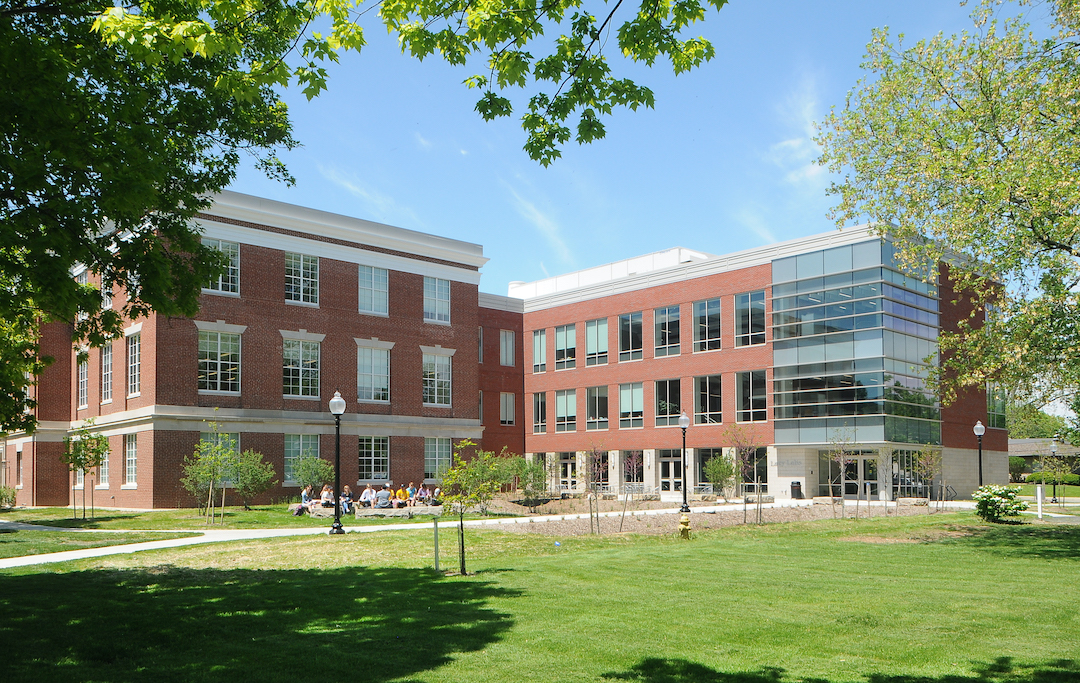Colleges, universities, corporations, and governments are finding that adapting older buildings to house laboratory facilities can be a viable alternative to new construction—if the conditions are right. When the right strategy is implemented, existing structures can be transformed into high-performance facilities.
FIVE FACTORS IN DECIDING WHETHER TO RENOVATE
When considering renovation, at least five criteria will help determine if the effort should be pursued:
- The campus is landlocked. If the campus is landlocked, or if there is a self-imposed restriction on increasing the total physical footprint, growth is limited to existing acreage or square feet. The demand for science and technology facilities is still on the rise, yet enrollments are projected to drop over the next 10 years. The University of Tulsa has taken action by reimagining its purpose and reorganizing its structure, including a STEM-heavy curriculum.
- Infrastructure has capacity. Most campuses have a utility loop of some kind, typically steam and chilled water. Yet when older buildings are renovated into research facilities, the robust MEP requirements can present a capacity challenge.
- Sustainability is a priority. Repurposing and upgrading existing facilities is one of the best ways to reduce-reuse-recycle. Construction waste doubled the amount of municipal waste in 2017, most of which came from demolishing buildings.
- Funding is limited. When funds are tight, renovating can be the most cost-effective solution. The cost of land acquisition can be extremely high, especially when landowners realize the value of the property for the institution. Moreover, the core and shell of existing buildings are already in place; their detail and character can be expensive to reproduce.
- There is historical value or alumni support. A once-popular building with sentimental value can motivate alumni to donate toward its preservation. Moreover, public perception of state and local projects typically favors renovation, especially when the character of a beautiful quadrangle or green space would be destroyed if a new facility were built.
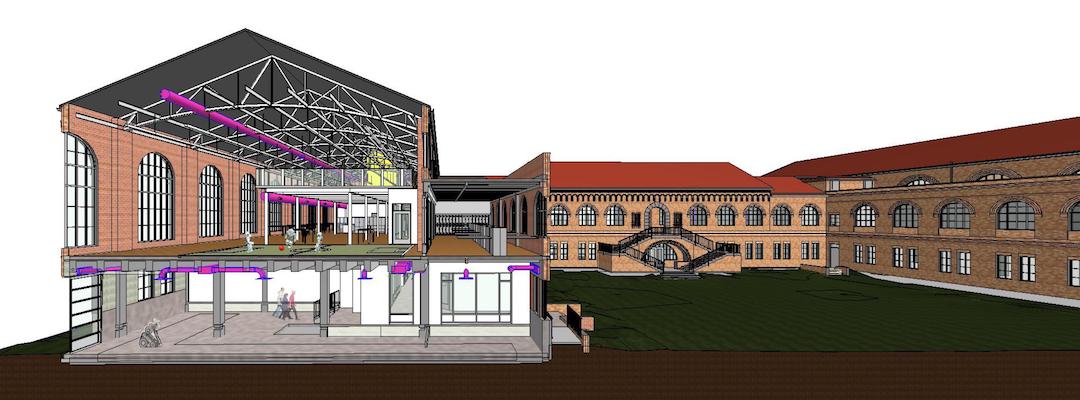
The Anna Hiss Gymnasium complex is being repurposed as a robotics laboratory at The University of Texas at Austin. All images courtesy BSA LifeStructures
At the University of Texas at Austin, there was great interest in preserving the Hiss Gymnasium, a twin-gymnasium women’s complex open since 1930. Named after Dr. Anna Hiss, a pioneer in women’s athletics, the building was historically significant for housing Dr. Hiss’s vision of advancing women’s sports programs. In addition, the gymnasium was a beautiful example of the signature Mediterranean features of blended camel exterior brick, red Spanish tile roof, arched windows, graceful patios, and deep roof overhangs set in the 1910 University campus plan.3
The building is being transformed into the Anna Hiss Robotics Institute, an interdisciplinary research center combining Robotics, Computer Science, Artificial intelligence, Mechanical and Electrical Engineering, and the Fine Arts College’s Industrial Design Department. The Army Futures Command will be located in the facility, bringing their robotic and positional and navigational technology research to partner with the university and the private sector.
THE BUDGET QUESTION: WILL THE JOB PENCIL OUT?
Renovating facilities typically cost less than building comparable new square footage. However, the building should be thoroughly evaluated for conditions and adaptability. There are numerous additional costs that are unique to renovation, including forensic engineering, as-built drawings, filed verifications, demolition, phasing plans, move management, temporary relocation, and remediation. An extended schedule resulting from demolition and phasing should also be accounted for in fees and general conditions.
All these issues should be analyzed and planned for by the project team. However, given there are no land acquisition costs and that a new core and shell would account for about 30% of construction costs, renovating can prove to be an affordable option.
KEEP SURPRISES TO A MINIMUM
Perhaps the biggest concern about renovating is unforeseen conditions. How can we prevent as many bad surprises as possible? Unforeseen conditions inevitably lead to change orders and additional costs. Removing the ceiling to get a look at what’s hidden is a start. But f the building can be vacated, the demolition is accelerated, and knowing exactly what is behind walls takes the mystery out of estimating and scheduling.
But not all buildings can be vacated. However, some surprises can be minimized through technology. 3D laser scanning brings a new level of accuracy and forensic information, which speeds the field verification as well as the design process.
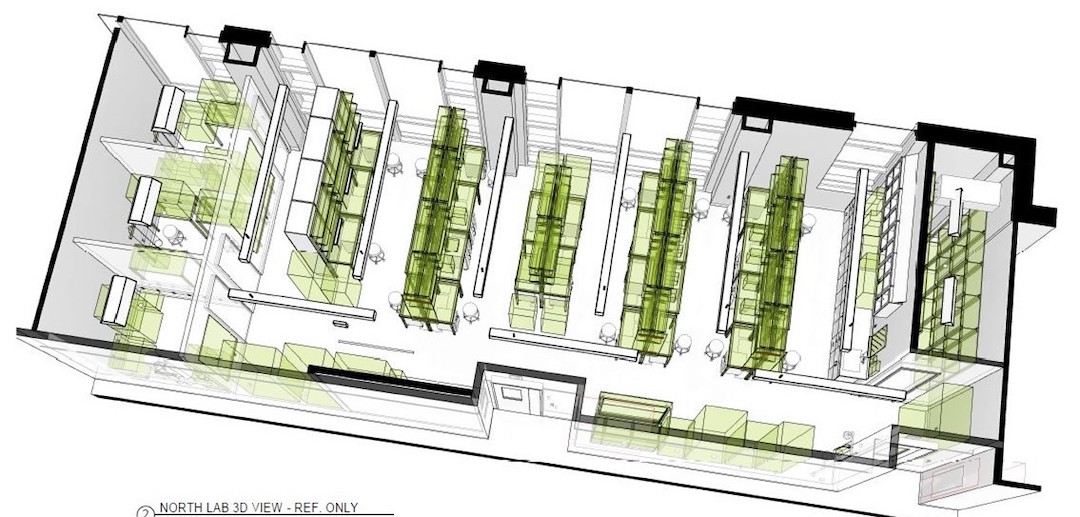
3D laser scanning, BIM, and virtual reality modeling allowed existing equipment from across the country to be fitted virtually and accurately at the new plant science lab at University of Texas at Austin. BIM model: BSA LifeStructures
The Torii Plant Science Lab is a renovation within the Neural and Molecular Science Building at the University of Texas. Dr. Keiko Torii, a faculty member at the University of Washington in Seattle and a Principal Investigator at Nagoya University in Japan, was scheduled to arrive in Austin during the construction of her new lab. Laser scanning made it easier for the design team to need her needs.
Dr. Torii, who has been called one of the 15 most innovative plant biologists in the U.S., was bringing several pieces of specialized equipment with her that needed to be test fitted to the space. The accuracy of the scans made accommodating the space and utility needs of the equipment much easier by eliminating countless filed verifications. The design team was also able to accurately modify the lab module to better fit the space and include a white boarding area.
Virtual reality technology has advanced to become a real-time design tool. A Midwest contract research organization’s space needs were recently studied, including labs for their product development department with windows on a tour route to keep guests out of the R&D areas. Clients can now wear VR goggles to be taken on a virtual tour of the space during design, led by an avatar of the designer. The views into the labs could be virtually seen, allowing for instant virtual sketches to make improvements.
GET YOUR SPACE ALLOCATIONS RIGHT
Space standards for teaching and research labs are constantly changing. STEM pedagogies such as eer-Led Team Learning and Process Oriented Guided Inquiry Learning advocate problem solving and team-based learning in the classroom. Research labs are becoming more specialized and have turned into collaborative, interdisciplinary facilities. Formulaic and standardized lab designs can render the space obsolete before construction is complete.
At Butler University, in Indianapolis, two 1970s-era science and technology buildings, Gallahue and Holcomb Halls, are being renovated and connected by a new third structure. All the sciences on the campus will be consolidated in the new complex. The theme of the new facility could be summed up in two words: collaboration and connection.
The class labs embrace the new pedagogies with team lab benches and seating to foster interaction. Researchers and students share prep areas and conduct some research together. Undergraduate research, recommended by the National Science Foundation, completely changes the undergraduate allocation standards for the sciences.
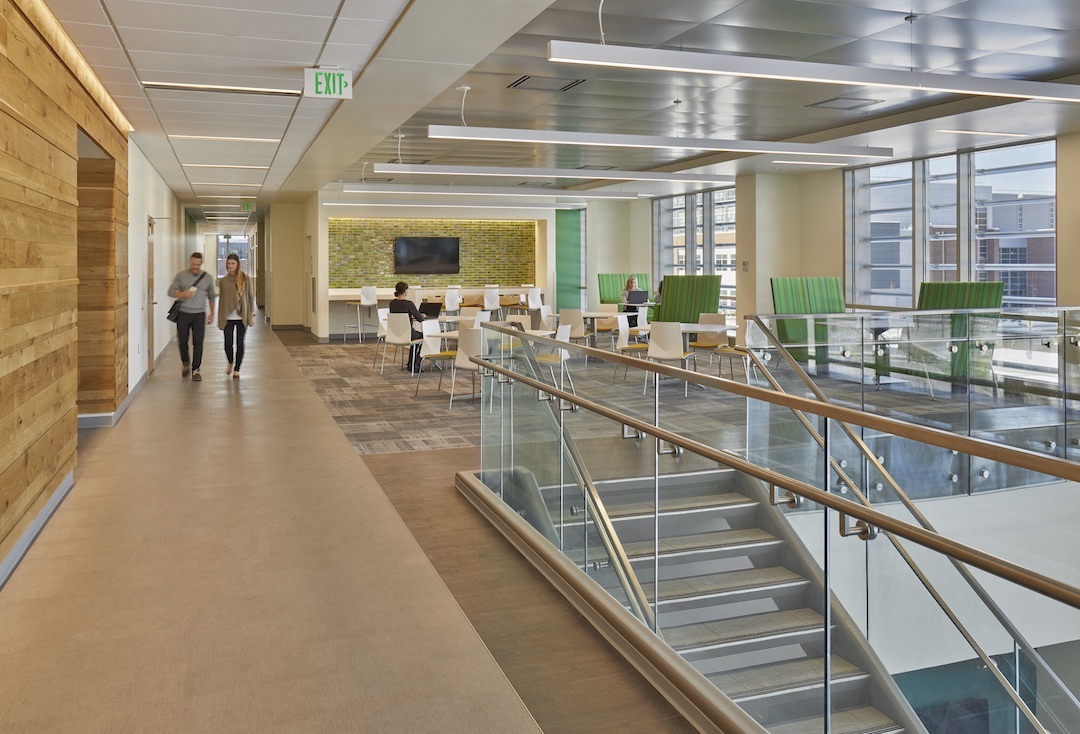
Collaboration areas, like these at Purdue University’s Hobart and Russell Creighton Hall of Animal Sciences, have increased the net programmed area in laboratory research and teaching facilities.
But the greatest change is found outside of the labs. Research has shown that interdisciplinary collaboration is key to new discoveries, and that the most productive collaborations happen outside of the work area. At Butler University, faculty and students interact in collaboration zones scattered throughout the facility. These areas are placed near the horizontal and vertical crossroads, creating informal gathering places. The success of these areas has caused their average total space in laboratory facilities to increase dramatically to nearly 20% of net square feet per student.
PROVIDING FOR SAFETY AND SECURITY
Renovations usually require additional safety improvements such as updated egress, fire sprinklers, and smoke evacuation systems. If the use of a building is being changed, the building must be updated to meet current codes. But the stakes are even higher in laboratory facilities.
A major research institution suffered a laboratory explosion when too much hydrogen built up in an anaerobic hood that was used to study bacteria. It serves as a grim reminder that safety is the top priority in laboratories.
Hood computational fluid dynamics (CFD) is a must to make sure air changes and hood containment are functioning properly to pull hood fumes away from users. Safety showers and eyewashes are standard safety equipment, but drains may be required or prohibited, depending on the jurisdiction.
Visibility is a safety concern, especially if newly trained undergraduates are conducting experiments. Instructors and lab managers need column-free views throughout the entire lab to be able to see their students.
The renovated facility will need a waste management strategy for biologics or chemicals to address such issues as the type and volume of waste and whether central or on-site storage/handling/holding facilities will be used.
If chemicals are going to be stored on site, the fire rating dictates the amount of storage allowed per floor.
Renovating a research building while it is occupied presents significant construction risks, notably:
- Isolating construction areas from the curious
- Rerouting vehicular and pedestrian traffic
- Controlling dusts, fumes and odors
- Eliminating tripping hazards
- Scheduling utility interruptions
UNDETECTED STRUCTURAL PROBLEMS CAN BE COSTLY TO REMEDIATE
Structural issues can be anything from potential structural failure to vibration stabilization. If extensive structural work is necessary to save an aging building, costs can reach beyond the typical cost of building a new facility, and creative solutions are called for.
Structural issues needed to be addressed at the Everitt Laboratory, which once housed the electrical engineering program at the University of Illinois at Urbana-Champaign, before it could become the new home of the Carle Illinois College of Medicine bioengineering department and the Jump Simulation Center.
The U-shaped building had a double-loaded corridor in one wing which did not work for the new cell and tissue culture teaching area. The prep areas needed to be on the same side of the corridor as the labs. The corridor was strategically shifted off-center to allow prep areas to be adjacent to the labs while burying the columns in the new walls.
By replacing the concrete masonry unit interior walls with drywall, the structural load was lightened to help limit the changes necessary to add a two-story infill. The infill is on top of a below-grade basement in the open U-shape of the building footprint. Only six columns needed reinforcement from helical tiers, with girders spanning three column pairs to support the infill.
REPLACING OUTDATED MEP SYSTEMS
Chances are that the mechanical and electrical systems in an older building are going to be inadequate. Furthermore, the demands of modern technology require an electrical capacity well beyond what was anticipated in previous decades. Computers, wireless technology, projection systems, and other technologies eat up space, generate heat, and suck up gobs of electricity.
Nearly every older facility will have lower floor-to-floor heights than their modern counterparts. Running ductwork is next to impossible. A little creativity, however, can uncover potential design opportunities when facing such challenges.
For example, the low floor-to-floor height at Miami University’s Pearson Hall, in Oxford, Ohio, limited the use of mechanical ductwork above the ceiling. A chilled beam system, which requires smaller air ducts, was the ideal choice for the lab. The lower operating cost provided a short payback period for the system.
At Indiana University’s School of Medicine, the Van Nuys Medical Science Building laboratories were updated to meet current standards. The floor-to-floor heights were even lower, so serving the new laboratory spaces with adequate HVAC systems was problematic. The solution: locate the new air-handling unit on the roof and create new mechanical chases down the exterior of the building to supply the labs vertically. The chases were incorporated into a new brick exterior of the building.
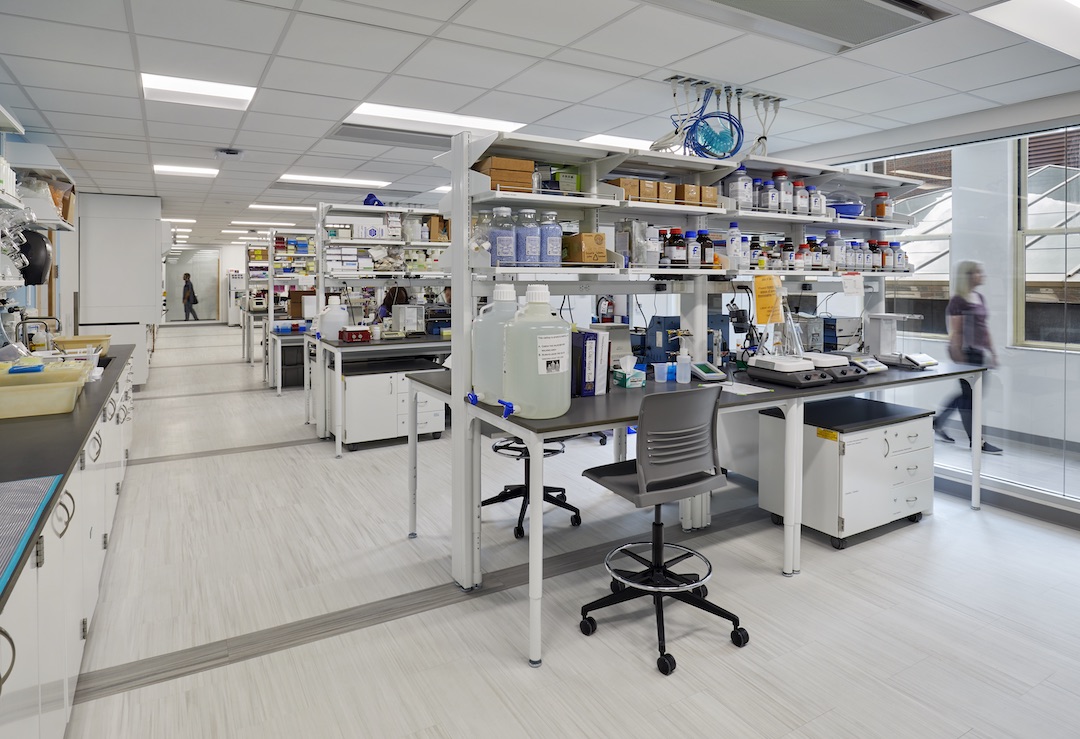
A chilled beam heating and cooling system in Miami University’s Pearson Hall was the right choice for the low floor-to-floor heights.
DEALING WITH PHASING AND DISRUPTION
Nothing can disrupt building activities like a multiphase renovation. But if carefully planned, noise, dust, and other inconveniences can be kept to a minimum. The Pearson Hall renovation at Miami University was such a project. The 201,000-sf facility housed biology and chemistry research labs and classrooms. The renovation was performed in seven phases over three years.
Ten researchers were relocated to unused library space across the street from Pearson; the vacated space in Pearson then served as swing space during the renovation. Construction was orchestrated in phases so that no other occupants had to move more than once.
Mechanically, the building was divided into quadrants. The phasing took advantage of the mechanical layout with a vertical phasing plan by quadrant.
TURNING DIFFICULTIES INTO OPPORTUNITIES
If handled correctly, many of the challenges associated with renovation of university science and technology buildings scan be turned into opportunities. Through careful planning and engaging an experienced design and construction team, renovation will remain a viable option for campuses across the U.S.
ABOUT THE AUTHOR
David Miller (dmiller@bsalifestructures.com) is the National Director of BSA LifeStructure’s Discovery practice. His 30-plus years of experience includes complex research and teaching environments in higher education, corporate research, and the health sciences.
Related Stories
Architects | Apr 6, 2023
Design for belonging: An introduction to inclusive design
The foundation of modern, formalized inclusive design can be traced back to the Americans with Disabilities Act (ADA) in 1990. The movement has developed beyond the simple rules outlined by ADA regulations resulting in features like mothers’ rooms, prayer rooms, and inclusive restrooms.
Sports and Recreational Facilities | Mar 30, 2023
New University of St. Thomas sports arena will support school's move to Division I athletics
The University of St. Thomas in Saint Paul, Minn., last year became the first Division III institution in the modern NCAA to transition directly to Division I. Plans for a new multipurpose sports arena on campus will support that move.
Designers | Mar 28, 2023
Inclusive design requires relearning how we read space
Pulling from his experience during a campus design workshop, David Johnson, AIA, LEED AP, encourages architects to better understand how to design spaces that are inclusive for everyone.
Healthcare Facilities | Mar 26, 2023
UC Davis Health opens new eye institute building for eye care, research, and training
UC Davis Health recently marked the opening of the new Ernest E. Tschannen Eye Institute Building and the expansion of the Ambulatory Care Center (ACC). Located in Sacramento, Calif., the Eye Center provides eye care, vision research, and training for specialists and investigators. With the new building, the Eye Center’s vision scientists can increase capacity for clinical trials by 50%.
Sports and Recreational Facilities | Mar 15, 2023
Georgia State University Convocation Center revitalizes long-neglected Atlanta neighborhood
Georgia State University’s new Convocation Center doubles the arena it replaces and is expected to give a shot in the arm to a long-neglected Atlanta neighborhood. The new 200,000 sf multi-use venue in the Summerhill area of Atlanta is the new home for the university’s men’s and women’s basketball teams and will also be used for large-scale academic and community events.
Sponsored | Cladding and Facade Systems | Mar 15, 2023
Metal cladding trends and innovations
Metal cladding is on a growth trajectory globally. This is reflected in rising demand for rainscreen cladding and architectural metal coatings. This course covers the latest trends and innovations in the metal cladding market.
Student Housing | Mar 13, 2023
University of Oklahoma, Missouri S&T add storm-safe spaces in student housing buildings for tornado protection
More universities are incorporating reinforced rooms in student housing designs to provide an extra layer of protection for students. Storm shelters have been included in recent KWK Architects-designed university projects in the Great Plains where there is a high incidence of tornadoes. Projects include Headington and Dunham Residential Colleges at the University of Oklahoma and the University Commons residential complex at Missouri S&T.
Virtual Reality | Feb 27, 2023
Surfing the Metaversity: The future of online learning?
SmithGroup's tour of the Metaversity gives us insight on bringing together physical and virtual campuses to create a cohesive institution.
University Buildings | Feb 23, 2023
Johns Hopkins shares design for new medical campus building named in honor of Henrietta Lacks
In November, Johns Hopkins University and Johns Hopkins Medicine shared the initial design plans for a campus building project named in honor of Henrietta Lacks, the Baltimore County woman whose cells have advanced medicine around the world. Diagnosed with cervical cancer, Lacks, an African-American mother of five, sought treatment at the Johns Hopkins Hospital in the early 1950s. Named HeLa cells, the cell line that began with Lacks has contributed to numerous medical breakthroughs.
Sustainability | Feb 9, 2023
University of Southern California's sustainability guidelines emphasize embodied carbon
A Buro Happold-led team recently completed work on the USC Sustainable Design & Construction Guidelines for the University of Southern California. The document sets out sustainable strategies for the design and construction of new buildings, renovations, and asset renewal projects.


